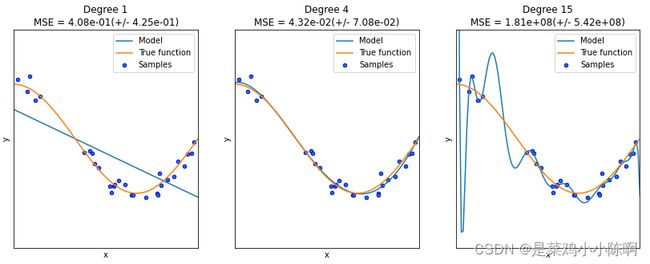sklearn——线性回归与逻辑回归
1. 线性回归
1.1 数据生成
线性回归是机器学习算法的一个敲门砖,为了能够更方便直观地带大家入门,这里使用人工生成的简单的数据。生成数据的思路是设定一个二维的函数(维度高了没办法在平面上画出来),根据这个函数生成一些离散的数据点,对每个数据点我们可以适当的加一点波动,也就是噪声,最后看看我们算法的拟合或者说回归效果。
import numpy as np
import matplotlib.pyplot as plt
def true_fun(X): # 这是我们设定的真实函数,即ground truth的模型
return 1.5*X + 0.2
np.random.seed(0) # 设置随机种子
n_samples = 30 # 设置采样数据点的个数
'''生成随机数据作为训练集,并且加一些噪声'''
X_train = np.sort(np.random.rand(n_samples))
y_train = (true_fun(X_train) + np.random.randn(n_samples) * 0.05).reshape(n_samples,1)
1.2 定义模型
生成数据之后,我们可以定义我们的算法模型,直接从sklearn库中导入类LinearRegression即可,由于线性回归比较简单,所以这个类的输入参数也比较少,不需要多加设置。 定义好模型之后直接训练,就能得到我们拟合的一些参数。
from sklearn.linear_model import LinearRegression # 导入线性回归模型
model = LinearRegression() # 定义模型
model.fit(X_train[:,np.newaxis], y_train) # 训练模型
print("输出参数w:",model.coef_) # 输出模型参数w
print("输出参数b:",model.intercept_) # 输出参数b
输出参数w: [[1.4474774]]
输出参数b: [0.22557542]
1.3 模型测试与比较
可以看到线性回归拟合的参数是1.44和0.22,很接近实际的1.5和0.2,说明我们的算法性能还不错。 下面我们直接选取一批数据测试,然后通过画图看看算法模型与实际模型的差距。
X_test = np.linspace(0, 1, 100)
plt.plot(X_test, model.predict(X_test[:, np.newaxis]), label="Model")
plt.plot(X_test, true_fun(X_test), label="True function")
plt.scatter(X_train,y_train) # 画出训练集的点
plt.legend(loc="best")
plt.show()
由于我们的数据比较简单,所以从图中也可以看出,我们的算法拟合曲线与实际的很接近。对于更复杂以及高维的情况,线性回归不能满足我们回归的需求,这时候我们需要用到更为高级一些的多项式回归了。
2. 多项式回归
多项式回归的思路一般是将
次多项式方程转化为线性回归方程,即将转换为(令
即可),然后使用线性回归的方法求出相应的参数。 一般实际的算法也是如此,我们将多项式特征分析器和线性回归串联,算出线性回归的参数之后倒推过去就行。
import numpy as np
import matplotlib.pyplot as plt
from sklearn.pipeline import Pipeline
from sklearn.preprocessing import PolynomialFeatures # 导入能够计算多项式特征的类
from sklearn.linear_model import LinearRegression
from sklearn.model_selection import cross_val_score
def true_fun(X): # 这是我们设定的真实函数,即ground truth的模型
return np.cos(1.5 * np.pi * X)
np.random.seed(0)
n_samples = 30 # 设置随机种子
X = np.sort(np.random.rand(n_samples))
y = true_fun(X) + np.random.randn(n_samples) * 0.1
degrees = [1, 4, 15] # 多项式最高次
plt.figure(figsize=(14, 5))
for i in range(len(degrees)):
ax = plt.subplot(1, len(degrees), i + 1)
plt.setp(ax, xticks=(), yticks=())
polynomial_features = PolynomialFeatures(degree=degrees[i],
include_bias=False)
linear_regression = LinearRegression()
pipeline = Pipeline([("polynomial_features", polynomial_features),
("linear_regression", linear_regression)]) # 使用pipline串联模型
pipeline.fit(X[:, np.newaxis], y)
scores = cross_val_score(pipeline, X[:, np.newaxis], y,scoring="neg_mean_squared_error", cv=10) # 使用交叉验证
X_test = np.linspace(0, 1, 100)
plt.plot(X_test, pipeline.predict(X_test[:, np.newaxis]), label="Model")
plt.plot(X_test, true_fun(X_test), label="True function")
plt.scatter(X, y, edgecolor='b', s=20, label="Samples")
plt.xlabel("x")
plt.ylabel("y")
plt.xlim((0, 1))
plt.ylim((-2, 2))
plt.legend(loc="best")
plt.title("Degree {}\nMSE = {:.2e}(+/- {:.2e})".format(
degrees[i], -scores.mean(), scores.std()))
plt.show()
2.1 交叉验证
在这个算法训练过程中,我们使用了一个技巧,就是交叉验证,类似的方法还有holdout检验以及自助法(交叉验证的升级版,即每次又放回去的选取数据)。 交叉验证法的作用就是尝试利用不同的训练集/测试集划分来对模型做多组不同的训练/测试,来应对测试结果过于片面以及训练数据不足的问题。
2.2 过拟合与欠拟合
我们知道多项式回归根据最高次数的不同,其回归的效果对于同一数据可能也不会不同,高次的多项式能够产生更多的弯曲从而拟合更多非线性规则的数据,低次的则贴近线性回归。 但在这过程中,也会产生一个过拟合与欠拟合的问题。
https://github.com/datawhalechina/machine-learning-toy-code/tree/main/ml-with-sklearn/LinearRegression
2. 逻辑回归
# 添加目录到系统路径方便导入模块,该项目的根目录为".../machine-learning-toy-code"
import sys
from pathlib import Path
curr_path = str(Path().absolute())
parent_path = str(Path().absolute().parent)
p_parent_path = str(Path().absolute().parent.parent)
sys.path.append(p_parent_path)
print(f"主目录为:{p_parent_path}")
from torch.utils.data import DataLoader
from torchvision import datasets
import torchvision
import torchvision.transforms as transforms
import matplotlib.pyplot as plt
from sklearn.linear_model import LogisticRegression
from sklearn.metrics import classification_report
import numpy as np
train_dataset = datasets.MNIST(root = p_parent_path+'/datasets/', train = True,transform = transforms.ToTensor(), download = False)
test_dataset = datasets.MNIST(root = p_parent_path+'/datasets/', train = False,
transform = transforms.ToTensor(), download = False)
batch_size = len(train_dataset)
train_loader = DataLoader(dataset=train_dataset, batch_size=100, shuffle=True)
test_loader = DataLoader(dataset=test_dataset, batch_size=100, shuffle=True)
X_train,y_train = next(iter(train_loader))
X_test,y_test = next(iter(train_loader))
# 打印前100张图片
images, labels= X_train[:100], y_train[:100]
# 使用images生成宽度为10张图的网格大小
img = torchvision.utils.make_grid(images, nrow=10)
# cv2.imshow()的格式是(size1,size1,channels),而img的格式是(channels,size1,size1),
# 所以需要使用.transpose()转换,将颜色通道数放至第三维
img = img.numpy().transpose(1,2,0)
X_train,y_train = X_train.cpu().numpy(),y_train.cpu().numpy() # tensor转为array形式)
X_test,y_test = X_test.cpu().numpy(),y_test.cpu().numpy() # tensor转为array形式)
X_train = X_train.reshape(X_train.shape[0],784)
X_test = X_test.reshape(X_test.shape[0],784)
# solver:即使用的优化器,lbfgs:拟牛顿法, sag:随机梯度下降
model = LogisticRegression(solver='lbfgs', max_iter=400) # lbfgs:拟牛顿法
model.fit(X_train, y_train)
y_pred = model.predict(X_test)
print(classification_report(y_test, y_pred)) # 打印报告
precision recall f1-score support
0 0.50 0.75 0.60 4
1 0.71 1.00 0.83 10
2 0.79 0.85 0.81 13
3 0.79 0.69 0.73 16
4 0.83 0.91 0.87 11
5 0.60 0.23 0.33 13
6 1.00 1.00 1.00 5
7 0.88 1.00 0.93 7
8 0.67 0.83 0.74 12
9 0.71 0.56 0.63 9
accuracy 0.75 100
macro avg 0.75 0.78 0.75 100
weighted avg 0.74 0.75 0.73 100
ones_col=[[1] for i in range(len(X_train))] # 生成全为1的二维嵌套列表,即[[1],[1],...,[1]]
X_train = np.append(X_train,ones_col,axis=1)
x_train = np.mat(X_train)
X_test = np.append(X_test,ones_col,axis=1)
x_test = np.mat(X_test)
# Mnsit有0-9十个标记,由于是二分类任务,所以可以将标记0的作为1,其余为0用于识别是否为0的任务
y_train=np.array([1 if y_train[i]==1 else 0 for i in range(len(y_train))])
y_test=np.array([1 if y_test[i]==1 else 0 for i in range(len(y_test))])
# solver:即使用的优化器,lbfgs:拟牛顿法, sag:随机梯度下降
model = LogisticRegression(solver='lbfgs', max_iter=100) # lbfgs:拟牛顿法
model.fit(X_train, y_train)
y_pred = model.predict(X_test)
print(classification_report(y_test, y_pred)) # 打印报告
precision recall f1-score support
0 1.00 0.98 0.99 90
1 0.83 1.00 0.91 10
accuracy 0.98 100
macro avg 0.92 0.99 0.95 100
weighted avg 0.98 0.98 0.98 100
https://github.com/datawhalechina/machine-learning-toy-code/tree/main/ml-with-sklearn/LogisticRegression

